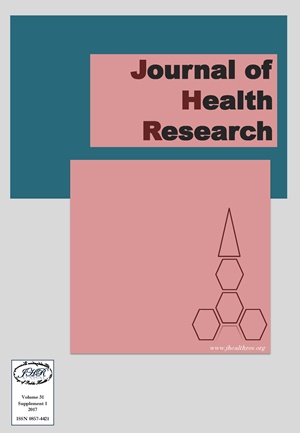Evaluation of One Year Workplace Oral Health Promotion Program in Factories
Keywords:
Workplace environment, Health education, Oral health, Oral health promotionAbstract
Background: The prevalence of oral diseases among Thai adults is constantly high. Oral health promotion programs rarely target adult groups. This study implemented a one year oral health promotion program in workplaces with the aim of improving knowledge, behaviors and the state of oral health in adult workers.
Methods: A total of six factories (191 workers) in Kaengkhoi district, Saraburi province, Thailand participated in the project. Select employees in three factories (92 workers) were designated to be in the control group. Select employees in two factories (69 workers) were designated to be in the Intervention I group lasting 1 year while employees in one factory (30 workers) were designated to be in the Intervention II group lasting a 6 month period. The two intervention groups were individually interviewed, and later discussed in group to design and create their own oral health-related activities. Oral health promotion activities occurring in the intervention I group included posters, morning talks, being reminded by headworkers to brush teeth after lunch and encouragement to reduce snacking during breaks. The Intervention II group only displayed education posters. No activities or educational material were supplied to the control group. Oral examinations, interview questionnaires to assess knowledge and behaviors were conducted at baseline, 6 months and 1 year periods. Data was compared for changes over the study period within all the three groups using Wilcoxon Signed Rank and Mc-Nemar tests, and changes between the control and the intervention groups were assessed using Mann-Whitney U and Chi-square tests.
Results: At the 6th month, the intervention I group improved knowledge and behaviors relating to frequency and duration of toothbrushing, type of toothpaste, food consumption habits and self-examination. At the end of the 1-year period, improvements of the intervention I group remained regarding duration of toothbrushing, type of toothpaste used and consumption habit. The intervention II group improved knowledge and behaviors for frequency of toothbrushing, consumption habit and self-examination. Comparing changes between the intervention I/II and the control group, intervention I group had significantly better improvement in knowledge regarding duration of tooth brushing and in behaviors regarding type of toothpaste, recommended drinks, dental examination and mouth rinse use. Intervention II group showed significantly better behavioral improvements on frequency of tooth brushing and dental examination.
Conclusion: A one year workplace oral health promotion program with a combination of education and community-initiated oral health activities improved oral health knowledge and behaviors of factory workers.






